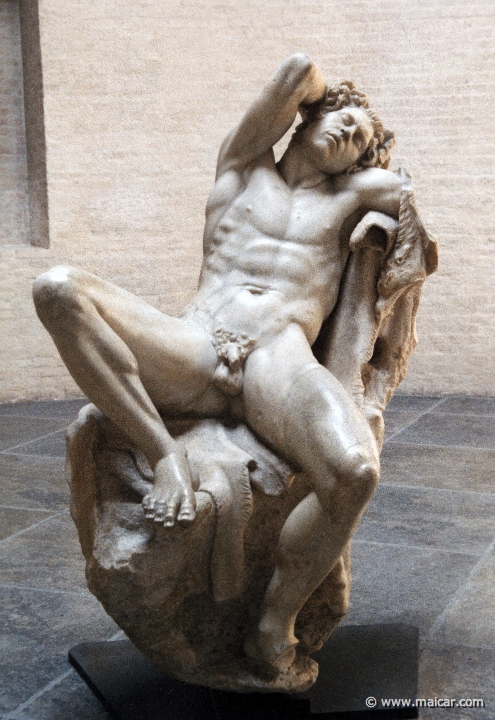|

|
Satyr defeated by wine and sleep. 0236: Faun from Palazzo Barberini. Statue from 220 BC. Glyptothek, München.
|
|
|
"Pan loved his neighbour Echo; Echo loved a frisking Satyr; and Satyr,
he was head over ears for Lyde. As Echo was Pan's flame, so was Satyr Echo's, and Lyde master Satyr's. It was
love reciprocal; for by just course, even as each
of those hearts did scorn its lover, so was it also
scorned being such a lover itself. To all such as
be heartwhole be this lesson read: If you would be
loved where you be loving, then love them that love
you." (Moschus 5).
|
|
SATYRS are called the attendants of Dionysus 2: great
lovers of wine and NYMPHS. Along with the MAENADS they form the
train of the god, dancing and singing.
Outraging islanders taken for SATYRS
Some have said that the SATYRS were not the
attendants of Dionysus 2, the god of the vine, but red-haired savages
living on certain islands of the Mediterranean sea.
Sailors have described them with tails upon their
flanks almost as long as those of horses. They said
that when these SATYRS caught sight of visitors
coming to their island, they ran down to the ship,
crying aloud, and coming on board they started to
assault the women in the ship.
How they are usually described
But this is not what is usually told of the
SATYRS, for when fancy sailor-tales are not
involved, they are the followers of the god of the
vine, who is the god of laughter, and are great
lovers of festivals, revels, drinking, dancing,
singing, and also many kinds of wild behavior, for
they have been accused of assaulting NYMPHS, and of stealing
cattle, although these things have been also done
by others who were not SATYRS. In any case, the
SATYRS are known for having made Dionysus 2 happy. Still others have said that the SATYRS lived in Ethiopia, and had hair upon their loins, and that they were taken along during an Egyptian campaign in that country because they were talented in dancing and singing, and no one understood better than them the secrets of relaxation and pastime. The Gauls were said to physically resemble the SATYRS. For they washed their blond hair in lime-water, and the treatment made it heavy and coarse like the mane of horses, and then pulled it back from the forehead to the top of the head, and back to the nape of the neck. The SATYRS are a mortal race, for some of their
graves, they say, have been seen in the land of the
Hebrews and at Pergamus. On the other hand, no one
ever seem to have doubted about their mortality,
since no one has said, for example, how Marsyas, who is called a
Satyr, could have survived what Apollo, in one of his
dark fits, did to him, a deed that the god himself
regretted.
Their asses won the battle
The SATYRS helped the OLYMPIANS in their war
against the GIANTS. It is
told that they came riding on asses, and when these
beasts caught sight of the GIANTS, they were
terrified letting out a braying such as the GIANTS had never heard,
for which reason they took to flight and were
defeated by the gods.
Another war
Otherwise, as the SATYRS are the permanent
attendants of Dionysus 2, attracted as they are by that fresh nectar
called wine, they also
followed him when the god campaigned in India. And as Dionysus 2 is a lover of noise, cymbals were attached, for
example to his ship, so that even if the SATYRS
were overcome by wine and
fell asleep, the god would not be without merry
sounds on his voyage.
Parties
And they could come to Andros, the most
northerly of the Cyclades Islands, where led by the
god they would give themselves to the spirits of
Laughter and Revel, who are very fond of the
drinking-bout. And not seldom are they seen asleep, for
dancing, singing, playing the flute, chasing NYMPHS, and drinking
great quantities of wine are, taken all together, exhausting activities. So
they often lie and sleep, breathing heavily as a
result of the wine. The SATYRS are often depicted as hardy and hot-blooded, having sometimes the tail of horses, and being altogether mischievous. Yet they are also charming, because of their dance and their laughter, and being given to love, they are able to subdue women by artful flatteries, despite the fact that there is no trace of delicacy in their bodies and their appearance is unkempt. And if words would not suffice, they could
induce echoing responses in the NYMPHS by the entrancing
music of the flute.
|